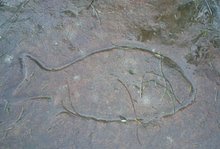 Wild weather events have brought forth two unusual phenomena at Manly Beach: erosion and plastic pellet pollution.
Wild weather events have brought forth two unusual phenomena at Manly Beach: erosion and plastic pellet pollution.
Erosion: At the south end , especially near the Life Saving Club the sand has dropped by 110 cm. Large chunks of cement, rusty iron pipes and sandstone are exposed. The stairs' foundations and the old infrastructural stumps have been exposed.
Plastic Pellets: Nurdle (pre-production plastic pellet or plastic resin pellet) are approximately 5mm in diameter, white or discoloured. All of it 'gets lost' in the industrial production and transportation of plastic products. Once in the ocean they become 'mermaid tears'. Many animals at the ocean become sick or die from them. In the end they enter the entire food chain. Additionally they leach plasticizers. They are also a transport medium of toxic chemicals (PCBs, DDE) in the marine environment. In the Great Pacific Garbage Patch giant amounts are in a vortex till the next  gyre hurls them in any direction.
gyre hurls them in any direction.
The plastic pellets have in the memory of Manly blog never been seen on the beach. There is also a lot of general plastic debris as well all along the beach.
Is there a marine science body responsible to monitor such occurences, or is it all up to the expertise of life savers? Links:
Links:
International Pellet Watch, Global Monitoring of Persistent Organic Pollutants (POPs) using Beached Plastic Resin Pellets.
Plastic Debris, Manly Beach
Coasts eroding, tag, abc
25 May 2009
Plastic Pellets and Erosion at Manly Beach
Tags
beforeandafter_image,
climate,
CO2,
coast,
erosion,
legacy,
Manly_beach,
plastic,
toxins
Subscribe to:
Post Comments (Atom)











2 comments:
Good article on the pellets (but sad). Those are referred to as "nurdles," and they are toxic, and bad for all marine life, and eventually us. You can help raise awareness to the way we have been using plastics in our daily lives by helping spread the word about Project Kaisei. This is a mission we are putting together to the plastic vortex in the Pacific to test catch methods, undertake science studies, and show that there may be a way to clean some of this up and then turn it to fuel.
If you paddle, surf, dive or sail, or just beach comb, please join us on World Ocean Day weekend (June 6th and 7th), and help get some of this plastic out of our seas. We are putting together a global cleanup for all ocean sports communities, so let us know what you do so we can add you to our list of clubs/participants.
http://www.projectkaisei.org/world.html
Thanks for the help. We can make change...but it all starts from the land, and how we use (or don't use) this stuff!
Doug
Project Kaisei
Start from the land:
Public clean water in durable ceramics jugs.
No plastic jugs or pitchers from styrene methyl methacrylate copolymer
No disposable filters/cartridges ending up in the tip or the ocean.
No surfing paraphernalia washed up on beaches
No anti-products of the polymer industry in the environment.
No ROVs whizzing in the habitat and migratory paths of marine mammals
No ocean dumping of 'externalities'
No shunning responsibility of the whole life cycle of a product
No PR spins raising "awareness" without a 'blogface'.
No viral event marketing or crisis management in the blogosphere.
Just clean public water and a smaller footprint and industries with ethics taking full (economic) responsibility for their 'externalities' floating anywhere.
Rita
MNLY Blog, Pacific Ocean
Post a Comment